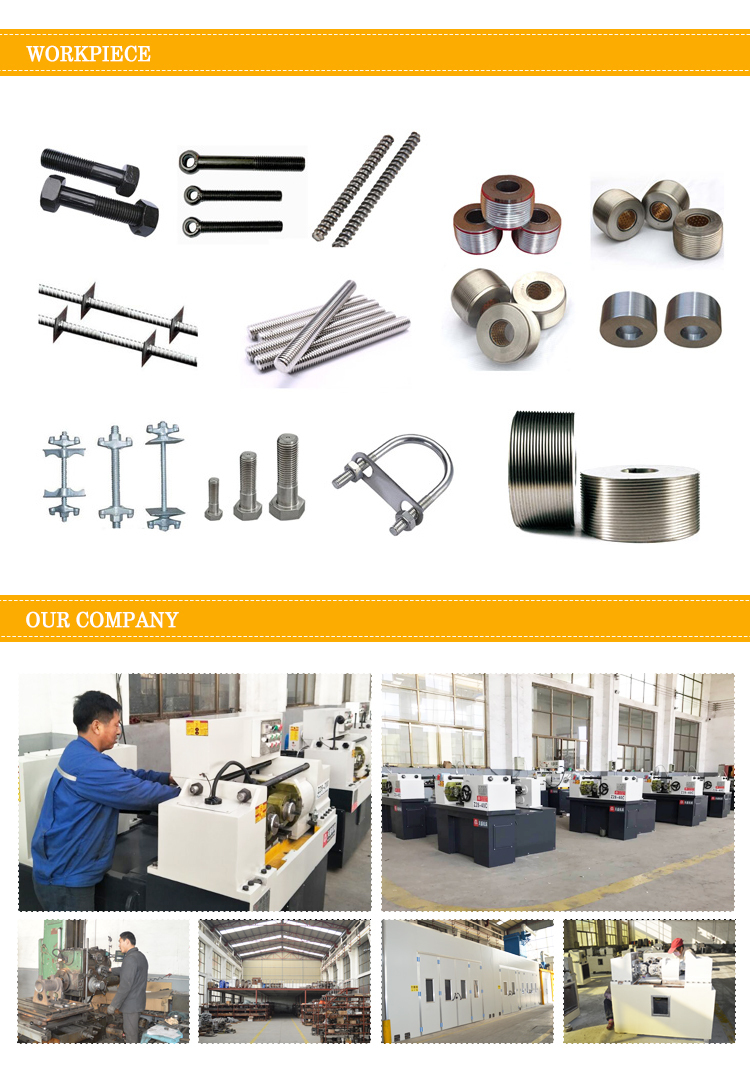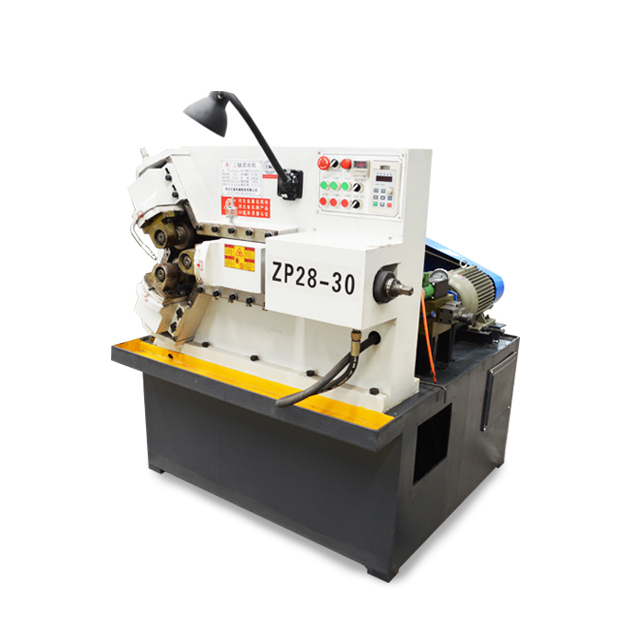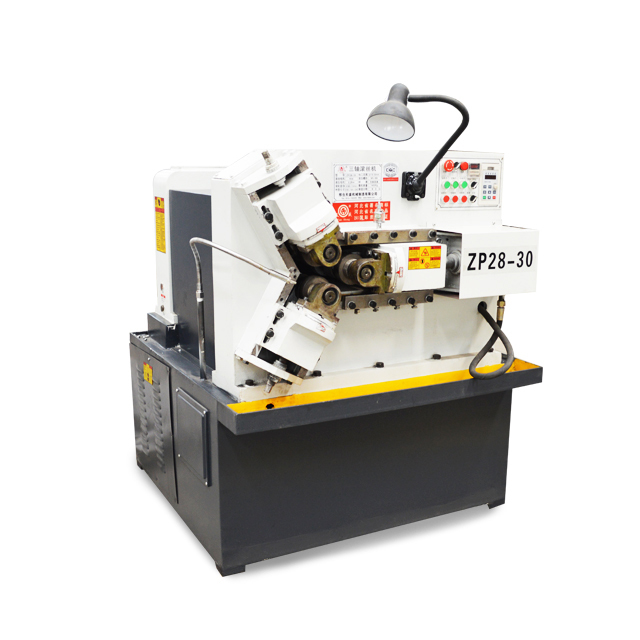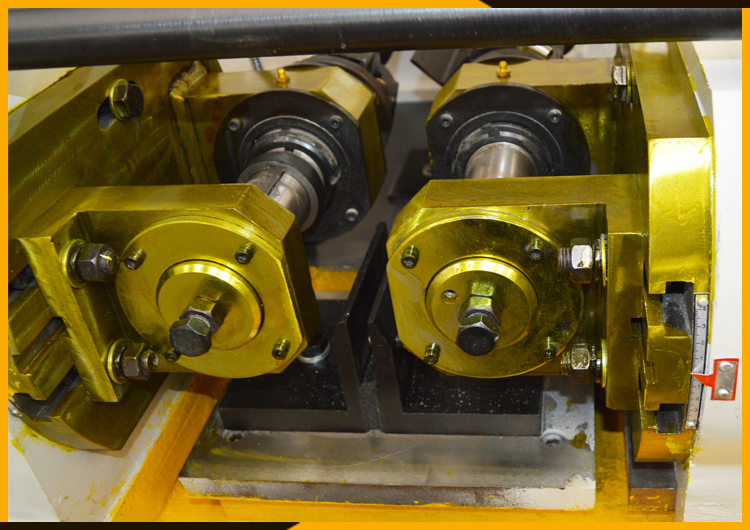huide
two round dies thread rolling machine
As a professional thread rolling machine manufacturer, we have an experienced and innovative R&D team that constantly launches new products that meet market demand and continuously improves the performance of existing products to improve product quality and stability. Our thread rolling machines have advanced production technology and equipment. From raw material selection to production and processing, they are produced in strict accordance with international standards and have reliable quality. Our target customers are all customers from all over world( Iraq,Cameroon,Singapore,Tunisia,Nepal,Isle of Man,Norway,Glorioso Islands,North America, America, Africa and Oceania) who need our product.
In addition to product quality, we also focus on customer service. We have a professional pre-sales consultation and after-sales service team to provide customers with considerate and thoughtful pre-sales technical consultation and after-sales technical support to meet customers' individual needs. In addition, we also provide customized services, designing and producing thread rolling machines according to customers' special needs, and providing customers with the best solutions.
| Product name | two round dies thread rolling machine |
| Keyword | thread roll forming machine,bolt thread rolling machine factory,circular thread rolling machine,thread rolling machine video,rolling thread machine,types of thread rolling machine,china screw machine thread rolling,hydraulic thread rolling machine manufacturer in ludhiana |
| Place of Origin | China |
| Production Capacity | 258~400/Per Min |
| Power | 2.2~6kw |
| Thread Dia(mm) | 2.0~4.0 |
| Core Components | Motor |
| Thread Length(mm) | 3~50 |
| Condition | New |
| Pre-Sales Service | Inquiry and consulting support. View our Factory. |
| Feature | pipe nipple threading machine in its rolling pressure range of cold, the workpiece for thread, ruled, twill and other treatment; straight, helical and oblique spline gear rolling; straightening, reducing diameter, rolling and various forming rolling. |
| Dimensions | 1796mm*1390mm*2089mm, (Contact us for specific information to confirm) |
| Applicable Industries | Building Material Shops, etc. |
| Advantages | two round dies thread rolling machine--It can be used to process scerw and rebar.The rebar processed by the machine has the good overall mechanical.It can make the tensile strength increased by 20%-30%,the fatigue strength increased by 40%-60%,corrosion resistance increased by 50%-200%.Mechanical properties of rebar connector reached and more than international standards. |
| Weight | 2338kg |
| Product Description | The machine has a safe and reliable electro-hydraulic execution and control system. Each work cycle can be selected in manual, semi-automatic and automatic ways. |
| terms of packing | enerally, we pack our goods in plywood cases. |
| terms of paymen | T/T 30% as deposit, and 70% balance against BL copy |
| Life span | 18 years (Contact us for specific information to confirm) |
| After-sale service | 12 months warrantly, man-made destory will be exception. |
| two round dies thread rolling machine Advantage | We keep good quality and competitive price to ensure our customers benefit |
| Packing | 2703x2396x1869mm(Contact us for specific information to confirm) |
| OEM/ODM | Customization Service Provided |
| Sales country | All over the world for example:Iraq,Cameroon,Singapore,Tunisia,Nepal,Isle of Man,Norway,Glorioso Islands |
| MOQ | 8pcs(Contact us for specific information to confirm) |
| Delivery time | 15-20 days for OEM, 5-7days for ready goods. |







two round dies thread rolling machine
huide-machinery.as one of the most professional two round dies thread rolling machine manufacturer has the advantages at:
We are the leader thread rolling machine supplier in China, also we have customers worldwide, such as America, Argentina, Brazil, Belarus, Bangladesh, Iraq,Cameroon,Singapore,Tunisia,Nepal,Isle of Man,Norway,Glorioso Islands, and Italy.We are factory specializing in the manufacture and export of thread rolling machine for more than 20 years, all of the production we sale are at a very best price and high quality.
We take care of our product quality, any defect of the goods, we will take responsibility. You are risk-free.And we believe that the good quality products will can give us survival, so, we always offer the top quality products to our customers, to keep them have the competitiveness in there market.
two round dies thread rolling machine services FAQs Guide
Are you looking for a quick review guide about two round dies thread rolling machineservices?
An ultimate FAQ buying guide is available to help you.This guide contains all the information about all the important facts, figures, and various processes regarding two round dies thread rolling machine services.
Let’s continue!
2.Can a two round dies thread rolling machine handle both internal and external threads?
3.What are the main features of a high-quality two round dies thread rolling machine?
4.Can a two round dies thread rolling machine Create Internal Threads?
5.Can a two round dies thread rolling machine create threads on curved or irregular surfaces?
6.How Does the Size and Shape of Threads Created by a two round dies thread rolling machine Affect Their Performance?
7. If the machine get damaged, what can I do ?
8.Are There Different Types of Thread Rolling Dies?
9.What is the Difference Between Annular and Circular Thread Rolling?
10.Can a two round dies thread rolling machine create threads on hardened materials?
11.How Does the Cost of a two round dies thread rolling machine Compare to Other Thread Forming Methods?
12.How Accurate are Threads Created by a two round dies thread rolling machine?
13.What are the Different Types of Thread Rolling Patterns?
1.What does your factory produce ?
We produce and export all kinds of Reinforced Bar Thread Rolling Machine with butt welding. We also can design and develop automatic wire ring making machines with butt welding according to your requirements.
2.Can a two round dies thread rolling machine handle both internal and external threads?
We focus on our customers' needs and strive to meet their expectations, so we take this very seriously.
Yes, some thread rolling machines are designed to handle both internal and external threads. These machines have different sets of dies and adjustments to accommodate the different types of threads. However, some machines may only be able to handle either internal or external threads, so it is important to check the specifications of the specific machine.
3.What are the main features of a high-quality two round dies thread rolling machine?
We have a wide range of two round dies thread rolling machine customer groups and establishes long -term cooperative relationships with partners. The countries we provide services include Iraq,Cameroon,Singapore,Tunisia,Nepal,Isle of Man,Norway,Glorioso Islands.
1. Robust Construction: A high-quality thread rolling machine should have a sturdy and durable construction to withstand the high pressure and stress of the rolling process.
2. Precision and Accuracy: The machine should be able to produce threads with high precision and accuracy, ensuring consistent and uniform thread quality.
3. High Production Capacity: A good thread rolling machine should have a high production capacity, allowing for efficient and fast production of threaded parts.
4. Easy to Operate: The machine should have a user-friendly interface and controls, making it easy for operators to set up and operate the machine.
5. Versatility: A high-quality thread rolling machine should be able to produce a wide range of thread sizes and types, making it suitable for various applications.
6. Low Maintenance: The machine should be designed for easy maintenance, with readily available spare parts and minimal downtime for repairs.

4.Can a two round dies thread rolling machine Create Internal Threads?
We have rich industry experience and professional knowledge, and have strong competitiveness in the market.
Yes, a thread rolling machine can create internal threads. This process is known as internal thread rolling and it involves using a set of dies to form the threads on the inside of a cylindrical workpiece. This method is commonly used for creating threads on nuts, bolts, and other fasteners. Internal thread rolling is a faster and more efficient process compared to traditional methods such as tapping or cutting, and it also produces stronger and more precise threads.
5.Can a two round dies thread rolling machine create threads on curved or irregular surfaces?
As one of the two round dies thread rolling machine market leaders, we are known for innovation and reliability.
No, a thread rolling machine is designed to create threads on flat or cylindrical surfaces only. It cannot create threads on curved or irregular surfaces.
6.How Does the Size and Shape of Threads Created by a two round dies thread rolling machine Affect Their Performance?
The size and shape of threads created by a thread rolling machine can greatly affect their performance in various ways. Some of the key factors that are influenced by the size and shape of threads include strength, durability, and compatibility with other components.
1. Strength: The size and shape of threads play a crucial role in determining their strength. Threads with larger diameters and deeper crests tend to be stronger and more resistant to shear forces. This is because they have a larger cross-sectional area, which allows them to distribute the load more evenly and withstand higher levels of stress.
2. Durability: The size and shape of threads also affect their durability. Threads with larger diameters and deeper crests are less prone to wear and tear, as they have a larger surface area in contact with the mating component. This reduces the pressure on individual threads and helps to distribute the load more evenly, thereby increasing their lifespan.
3. Compatibility: The size and shape of threads also determine their compatibility with other components. Threads that are too large or too small may not fit properly with the mating component, leading to issues such as thread stripping or loosening. Additionally, threads with irregular shapes or poor surface finish may not provide a tight and secure fit, which can affect the overall performance of the assembly.
4. Thread engagement: The size and shape of threads also affect the amount of thread engagement, which is the length of the thread that is in contact with the mating component. Threads with larger diameters and deeper crests have a longer thread engagement, which provides a stronger and more secure connection between the components.
In conclusion, the size and shape of threads created by a thread rolling machine can have a significant impact on their performance. It is important to carefully consider these factors when designing and manufacturing threaded components to ensure optimal strength, durability, and compatibility.

7. If the machine get damaged, what can I do ?
In the guarantee time (15 months) , we will send the spare parts to you for free and provide the technical consultant for anytime. If more terrible, we can send our engineers to your factory. We will provide same good after-sale service as the pre-sale service. For any of your questions, we will reply within 12 hours.
8.Are There Different Types of Thread Rolling Dies?
We pay attention to the transformation of intellectual property protection and innovation achievements. Your OEM or ODM order design we have a complete confidentiality system.
Yes, there are different types of thread rolling dies, including:
1. Flat dies: These are the most common type of thread rolling dies and are used for producing external threads on cylindrical parts.
2. Circular dies: These dies have a curved profile and are used for producing threads on conical or tapered parts.
3. Planetary dies: These dies have multiple thread profiles on a single die and are used for producing threads on complex or non-cylindrical parts.
4. Rack dies: These dies have a straight, toothed profile and are used for producing threads on long, thin parts such as screws or bolts.
5. Knurling dies: These dies have a serrated profile and are used for producing knurled patterns on cylindrical parts.
6. Thread forming dies: These dies do not cut material but instead deform it to create threads. They are used for producing threads on soft or brittle materials.
7. Combination dies: These dies have multiple thread profiles on a single die and can be used for both rolling and cutting threads.
8. Adjustable dies: These dies have adjustable thread profiles and are used for producing threads of different sizes on the same die.
9. Tapered dies: These dies have a tapered profile and are used for producing tapered threads on parts such as pipes or fittings.
10. Thread chasers: These dies are used for repairing damaged threads on existing parts. They have a cutting profile that matches the damaged thread and can be used to restore it to its original size and shape.
9.What is the Difference Between Annular and Circular Thread Rolling?
We have been working hard to improve service quality and meet customer needs.
Annular and circular thread rolling are two methods used to create threads on cylindrical parts. The main difference between these two methods lies in the shape of the thread produced.
Annular thread rolling is a process in which a cylindrical part is rotated between two dies, one of which has a thread-shaped groove. As the part is rotated, the dies move together, pressing the thread-shaped groove into the surface of the part, creating a helical thread. This method produces threads with a triangular cross-section, with rounded peaks and valleys.
On the other hand, circular thread rolling is a process in which a cylindrical part is rotated between two dies, both of which have thread-shaped grooves. As the part is rotated, the dies move together, pressing the thread-shaped grooves into the surface of the part, creating a helical thread. This method produces threads with a circular cross-section, with sharp peaks and valleys.
In summary, the main difference between annular and circular thread rolling is the shape of the thread produced. Annular thread rolling produces triangular threads, while circular thread rolling produces circular threads. The choice between these two methods depends on the specific requirements of the application and the desired thread shape.

10.Can a two round dies thread rolling machine create threads on hardened materials?
Our company has many years of two round dies thread rolling machine experience and expertise.
Yes, a thread rolling machine can create threads on hardened materials.
The process of thread rolling involves pressing a hardened steel die onto the surface of the material, which displaces the material and forms the threads. This process is suitable for creating threads on a wide range of materials, including hardened materials such as stainless steel, titanium, and hardened steel. However, the hardness of the material may affect the speed and efficiency of the thread rolling process. It is important to use the appropriate die and machine settings for the specific material being threaded to ensure the best results.
11.How Does the Cost of a two round dies thread rolling machine Compare to Other Thread Forming Methods?
We continue to improve two round dies thread rolling machine products and processes to improve efficiency.
The cost of a thread rolling machine can vary depending on the size, type, and features of the machine. However, in general, thread rolling machines tend to be more expensive than other thread forming methods such as tapping or die cutting.
One of the main reasons for this is that thread rolling machines are more complex and require more precision in their design and construction. They also have a higher production capacity and can produce threads at a faster rate compared to other methods.
Additionally, thread rolling machines require specialized tooling and dies, which can add to the overall cost. However, once the initial investment is made, thread rolling machines can be more cost-effective in the long run due to their efficiency and durability.
In comparison, tapping and die cutting methods may have lower upfront costs, but they may require more frequent tooling replacements and have slower production rates, leading to higher long-term costs.
Overall, the cost of a thread rolling machine may be higher initially, but it can provide significant cost savings and efficiency in the long run.
12.How Accurate are Threads Created by a two round dies thread rolling machine?
We are centered on customers and always pay attention to customers' needs for two round dies thread rolling machine products.
Threads created by a thread rolling machine are highly accurate and precise. This is because thread rolling is a cold forming process that uses pressure to deform the material into the desired thread shape. This results in a thread with a smooth surface and consistent dimensions.
The accuracy of threads created by a thread rolling machine depends on several factors such as the quality of the machine, the material being rolled, and the skill of the operator. However, in general, thread rolling machines can produce threads with tolerances as tight as 0.0005 inches.
Compared to other methods of creating threads, such as cutting or grinding, thread rolling offers superior accuracy and consistency. This is because the material is not removed during the process, resulting in a stronger and more precise thread.
In addition, thread rolling machines are designed to produce threads with high repeatability, meaning that each thread produced will be nearly identical to the previous one. This makes them ideal for high-volume production of threaded parts.
Overall, the accuracy of threads created by a thread rolling machine is very high, making it a preferred method for creating threads in various industries such as automotive, aerospace, and construction.

13.What are the Different Types of Thread Rolling Patterns?
We have a good reputation and image in the industry. The quality and price advantage of two round dies thread rolling machine products is an important factor in our hard overseas market.
1. Straight Thread Rolling: This is the most common type of thread rolling pattern, where the threads are rolled in a straight line along the length of the workpiece.
2. Helical Thread Rolling: In this pattern, the threads are rolled in a helical or spiral shape around the workpiece. This type of pattern is commonly used for creating threads on screws and bolts.
3. Diamond Thread Rolling: In this pattern, the threads are rolled in a diamond shape, with each thread intersecting at a 60-degree angle. This pattern is commonly used for creating threads on fasteners and fittings.
4. Knurling Thread Rolling: This pattern is similar to diamond thread rolling, but the threads are rolled in a knurled pattern, creating a rough surface for better grip. This type of pattern is commonly used for creating threads on handles and knobs.
5. Worm Thread Rolling: In this pattern, the threads are rolled in a spiral shape, similar to a worm gear. This type of pattern is commonly used for creating threads on gears and other mechanical components.
6. Acme Thread Rolling: This pattern is characterized by a trapezoidal shape, with flat tops and bottoms and angled sides. It is commonly used for creating threads on lead screws and other power transmission components.
7. Buttress Thread Rolling: This pattern is similar to Acme thread rolling, but with one side of the thread at a steeper angle. It is commonly used for creating threads on heavy-duty applications, such as in the oil and gas industry.
8. Square Thread Rolling: In this pattern, the threads are rolled in a square shape, with sharp corners. It is commonly used for creating threads on precision instruments and machinery.
9. Round Thread Rolling: This pattern is similar to square thread rolling, but with rounded corners. It is commonly used for creating threads on delicate materials, such as plastics and soft metals.
10. Multiple Thread Rolling: In this pattern, multiple threads are rolled simultaneously, creating a faster and more efficient process. It is commonly used for creating threads on high-volume production runs.
- Place of Origin:
- Video outgoing-inspection:
- Machinery Test Report:
- Marketing Type:
- Warranty of core components:
- Core Components:
- Key Selling Points:
- Applicable Industries:
- Application:
- Condition:
- Production Capacity:
- Voltage:





















